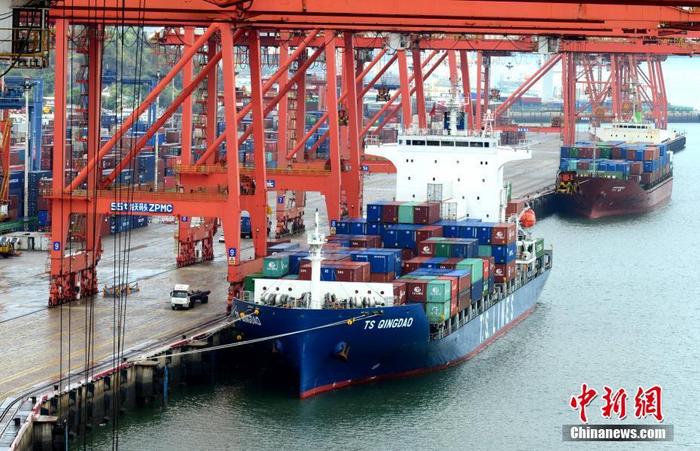(Economic Observation) What "hurdles" will China's economy need to overcome in the next 5 years?
China News Agency, Beijing, November 17th, title: In the next five years, what "hurdles" will China's economy need to overcome?
China News Agency reporter Pang Wuji
The "13th Five-Year Plan" is coming to an end, and the next five years are about to start. In the face of major changes unseen in a century, what "hurdles" does the Chinese economy need to overcome?
On the 17th, the State Council Information Office held a briefing. A number of experts from the Chinese Academy of Social Sciences were present to analyze the trend of China's economy in the next five years, and put forward the challenges facing the Chinese economy in terms of finance, real economy, and consumption.
The data picture shows a container terminal.
Photo by China News Agency reporter Wang Dongming
Stable leverage
Zhang Xiaojing, director of the Institute of Finance of the Chinese Academy of Social Sciences, said that due to special effects such as the epidemic, China's macro leverage ratio has risen rapidly this year. The first three quarters have increased by 27.7 percentage points, and the leverage ratio exceeds 270%, which means that the debt scale is equivalent to GDP. 2.7 times, which is a relatively high level. It is expected that the macro leverage ratio will increase by about 30% this year.
The reason for the rapid increase in leverage is not because debt is expanding too fast, Zhang Xiaojing explained, but because GDP growth this year is too slow, and most countries have experienced negative GDP growth this year.
There are two points of concern about the risks of rising leverage. One is the increase in bad debts of small and medium-sized banks, which will be reflected in the total amount; second, when the leverage is high, the annual interest payment is also high, and the highest year interest payment once reached Twice the incremental GDP, preliminary estimates this year are 1.5 to 2 times the incremental GDP.
However, Zhang Xiaojing also said that from the horizontal and vertical comparison, this increase is still controllable.
Zhang Xiaojing said that China's leverage ratio rose by 31.8 percentage points throughout 2009, higher than this year's level.
In addition, from a global perspective, there are forecasts that the global leverage ratio will rise by 35 percentage points this year, and China is also below this average level.
He pointed out that on the one hand, China’s economy is the first to recover from the epidemic. If this momentum can continue, the increase in China’s leverage ratio in the next five years will be close to the level of this year, which means that in the next five years, it will increase by about 5-6 per year. Percentage points.
On the other hand, according to the latest estimates, the Chinese government's broad net assets exceeded the level of RMB 120 trillion in 2016, and it is fully capable of stabilizing leverage.
Be wary of "de-industrialization" too fast
Huang Qunhui, director of the Institute of Economics of the Chinese Academy of Social Sciences, pointed out that premature de-industrialization may be one of the biggest risks to the Chinese economy in the next five years.
From a theoretical analysis, in the process of modernization, as a country's per capita income increases, the share of manufacturing will gradually decline.
However, Huang Qunhui pointed out that it needs to be noted that the manufacturing industry itself has innovation effects, industry linkage effects and foreign exchange reserve effects. If these effects are not fully utilized, the proportion of manufacturing industry will decline rapidly, which will cause premature "deindustrialization".
Huang Qunhui believes that if the proportion of certain low-efficiency service industries increases rapidly while the proportion of relatively high-efficiency industries declines rapidly, it will inevitably lead to a decline in overall economic growth and a simultaneous decline in efficiency.
This may cause a country to fall into a "middle income trap."
Looking at the world, Japan, South Korea, Germany, etc., per capita GDP has reached the level of 30,000 to 40,000 US dollars, but the proportion of manufacturing still remains above 20%.
The proportion of China's manufacturing industry has declined rapidly in recent years.
At present, China's per capita GDP has exceeded 10,000 U.S. dollars, and the manufacturing industry accounts for less than 30%.
Therefore, it is necessary to maintain a stable proportion of manufacturing.
The "Proposals of the Central Committee of the Communist Party of China on Formulating the Fourteenth Five-Year Plan for National Economic and Social Development and Long-Term Goals for 2035" also clearly stated that "maintain the basic stability of the manufacturing sector and consolidate the foundation of the real economy."
Substantial progress in income distribution reform
China proposes to "form a new development pattern in which domestic and international cycles are the mainstay and the domestic and international dual cycles promote each other" as a major strategic choice in the new development stage.
Zhang Xiaojing believes that the formation of a large domestic cycle requires consumption driving, and if the problem of income distribution is not solved, then consumption driving cannot be formed.
In the "14th Five-Year Plan" proposal, in the basic realization of the long-term goal of socialist modernization by 2035, it is proposed that "the common prosperity of all people will achieve more obvious substantive progress", and the part of improving the quality of life of the people emphasizes "solid Promote common prosperity".
Zhang Xiaojing believes that this is a mission statement, which is both a major challenge and an important task for the next five years.
(Finish)

